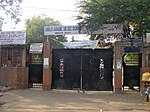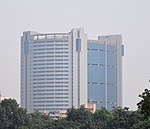New Delhi railway station

New Delhi railway station (station code: NDLS) is the main railway station in Delhi, situated between Ajmeri Gate and Paharganj. It is one of the busiest railway station in the country in terms of train frequency and passenger movement. Around 480 trains start, end, or pass through the station daily, which handled 500,000 passengers daily in 2013 with 16 platforms. The New Delhi railway station holds the record for the largest route interlocking system in the world along with the Kanpur Central railway station i.e. 48. The station is about two kilometres north of Connaught Place, in central Delhi. Most eastbound and southbound trains originate at New Delhi railway station; however, some important trains to other parts of the country also touch/originate at this station. Most pairs of Shatabdi Express originate and terminate at this station. It is also the main hub for the Rajdhani Express. New Delhi railway station is the highest-earning railway station in Indian Railways based on passenger revenue followed by Howrah Junction.
Excerpt from the Wikipedia article New Delhi railway station (License: CC BY-SA 3.0, Authors, Images).New Delhi railway station
State Entry Road, New Delhi New Delhi Railway Station (Chanakya Puri Tehsil)
Geographical coordinates (GPS) Address Nearby Places Show on map
Geographical coordinates (GPS)
| Latitude | Longitude |
|---|---|
| N 28.6417 ° | E 77.2207 ° |
Address
8-9
State Entry Road
110055 New Delhi, New Delhi Railway Station (Chanakya Puri Tehsil)
Delhi, India
Open on Google Maps








